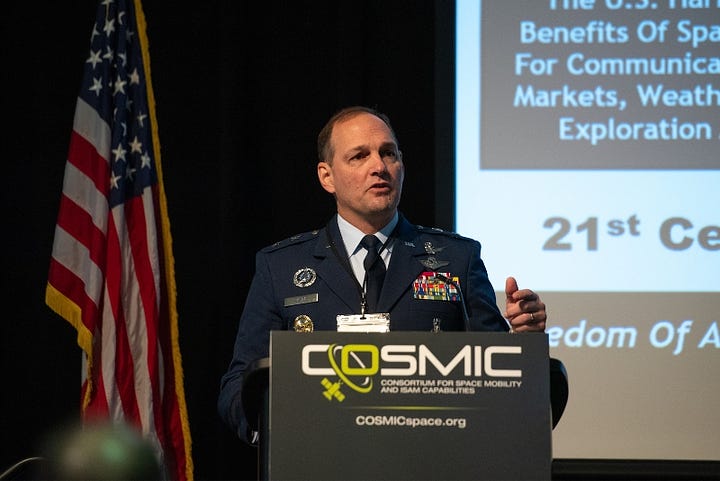
Hello DownLink Listeners!
Science fiction is science now… Well… Close enough to motivate NASA’s Space Technology Mission Directorate (STMD) into bringing together leaders from the civil, commercial, and defense space sectors, along with academia, to form a consortium to develop the In-Space Servicing, Assembly and Manufacturing (ISAM) technologies vital to the near-future space economy and to space security.
According to the website, the consortium, named COSMIC, aims “to execute activities that align to the ISAM National Strategy and National ISAM Implementation Plan.” COSMIC Executive Director Greg Richardson, who is no stranger to national security space missions and is a guest this week, wants way more than just talk and cocktail receptions. He wants a nation-wide effort that includes the U.S. Space Force pitching-in.
“ISAM is bigger than any one agency. And if we are ever going to get to a point where ISAM becomes routine... We can't have agencies doing it alone. We can't have companies doing it alone. We need a whole of nation effort, and that's where COSMIC comes in,” Richardson told me.
And he’s not alone in his opinion.
Experts say that the space economy will only really take off once we humans have developed a lot of very smart space-faring robots that can do things like refuel, maintain, and repair other spacecraft or build structures great and small in space, such as space stations.
If you haven’t yet noticed, the key distinction between the regular servicing missions taking place aboard the International Space Station and the promise of ISAM technologies, is that the work will be done by smart robots, and not require humans to perform extravehicular activities or EVAs.

The U.S. Space Force is particularly interested in ISAM technologies to satisfy Space Access, Mobility and Logistics (SAML) mission sets, such as assured access to space, rendezvous and proximity operations, and space domain awareness.
U.S. Space Force Maj. Gen. John Olson, also a guest on this week’s episode, calls the suite of ISAM technologies now under development a “core part of our vision for the future” and “critical” to the development of the space economy as well as to the dynamic space operations that will be necessary to secure that economy.
The Department of Defense has been spending money on ISAM-related contracts with space companies such as Obit Fab, a refueling venture featured in a recent episode; and Scientific Systems, which in October received a $1.5 Million STTR Phase II contract, under the SpaceWERX Orbital Prime Program to develop its “vision-based solution, for US-RIPTIDE (Unknown Satellite Realtime Inspection, Pose, Tracking and IDEntification).”
What I found especially interesting from one of Maj. Gen. Olson’s slides (just above) was this definition of SAML: “The Movement and Support of Equipment and Personnel In, From, and To/Through the Space Domain.” Someone in Space Force is thinking about a future where Guardians will be astronauts performing military missions.
Who’s in this episode


Maj. Gen. John Olson - United States Space Force, Mobilization Assistant to the Chief of Space Operations and Space Force lead for JADC2 and ABMS
Greg Richardson - Executive Director, COSMIC, and a Senior Project Leader, The Aerospace Corporation
Here’s the policy
According to the National In-Space Servicing, Assembly, And Manufacturing Implementation Plan, “ISAM is a suite of capabilities, which are used on-orbit, on the surface of celestial bodies, and in transit between these regimes.”
And in case you missed it


In the last two weeks, NASA Administrator Bill Nelson has been busy bringing the nations of The Netherlands and Bulgaria on to team Artemis. That raises the number of signatories to the Artemis Accords to 32. The China-led International Lunar Research Station, or ILRS, includes China, Russia, Venezuela, Pakistan, United Arab Emirates, South Africa, Azerbaijan, and Belarus, which joined this October. Here’s a handy ILRS tracker from Reuters. Of note, the UAE has signed up to both coalitions, which may, or may not, make that nations full participation in either tricky.
The reason I’m including these lunar coalitions in this week’s newsletter is because of their direct connection to the sovereign ISAM technologies the COSMIC consortium will work to develop. What’s key to remember is that Section 5 of the Artemis Accords is about “the development of interoperable and common exploration infrastructure and standards, including but not limited to fuel storage and delivery systems, landing structures, communications systems, and power systems.”… That’s ISAM.
Here’s a great timeline on ISAM technological development and deployment from New Space Economy.
And this just in…
The US Federal Aviation Administration’s Current Operations Plan Advisory includes Space X Starship Super Heavy Flight 2 from Boca Chica, Texas, with the launch window opening on Friday, November 17. Many in the commercial sector who are working to make ISAM a reality sooner rather than later point to the Starship Heavy as a huge game-changer because if it works, launch costs will be slashed.
Peter Garretson, a regular guest on The DownLink Podcast, wrote in his paper “The Starship Singularity” for the American Foreign Policy Council’s Space Policy Review, that, “Starship’s reusability makes possible the delivery of cargo to low Earth orbit for an ultra-low cost (below $1,000/kg immediately, and $100/kg in two to three years)”.
So logically, money saved on launch can then be redirected to technology development, which would certainly decrease the time it would take to get from idea to deployment and profit.
You can watch the Starship second flight test here on the SpaceX website. The time is TBD. If weather becomes and issue the launch window extends through Sunday, November 19.
Ad Astra,
Laura














